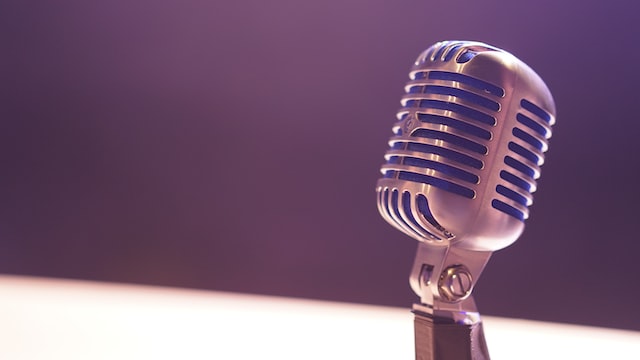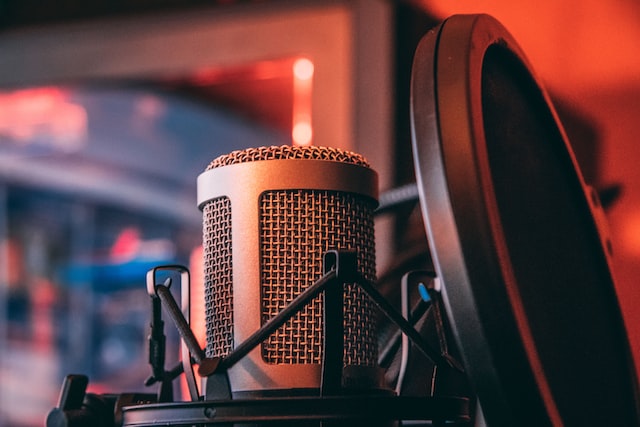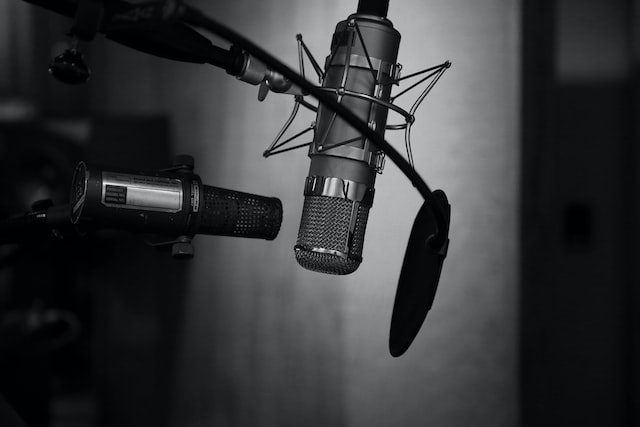AudioReputation is reader-supported. When you buy through links on our site, we may earn an affiliate commission Learn More

Many musicians, broadcasters, and different audio professionals face a common problem while recording their audio called mic peaking. This happens when the volume of your microphone input exceeds the maximum level of your recording equipment. When these tools fail to handle the volume of your audio, you hear a distorted and overdriven sound.
And, if you are also going through this problem, then you are in the right place.
In this article, I’ll cover almost all the important aspects of mic peaking and even provide actionable tips to fix this problem instantly. Not just that, I’ll also talk about how you can avoid this common audio recording problem in the first place so you can capture pristine and clear audio every time. So, whether you’re a seasoned pro or a newbie in audio recording, this article will assist you in getting the best possible sound from your microphone.
Table of Contents
What Is Microphone Peaking?
When the wavelength of the sound sent to the diaphragm of your microphone exceeds a certain limit, your microphone fails to pick it up, which causes distortions in the recorded audio. These sound distortions are called microphone peaking.
Loud noises can cause microphone peaking, and this mostly happens when you speak too loudly into the microphone. Not only that, but cheap microphones also cause microphone peaking as they are less fine-tuned than expensive ones.
That’s why paying proper attention to which type of microphone suits you the best might just save your recording, as different types of microphones suit different types of purposes. For example, if you are recording a podcast, then single-directional microphones should do the job properly, but if you shout a lot or have multiple sources or people speaking into the microphone, then you might need an omnidirectional mic. In short, you should pay close attention to the kind of microphone you are using to ensure a clean recording and avoid any kind of distortion.
How To Prevent Microphone Peaking?
Here is how you can instantly prevent your microphone from peaking while recording any audio.
1. Using the Right Microphone
Choosing the right microphone is a vital part of getting a distortion-free audio output, as there are many types of microphones for different purposes and uses. Some microphones might offer you bigger diaphragms for better distortion control. On the other hand, some offer a wider range and direction for picking up minute sounds. Each of these mics is different in its own way and has its own place, but for reducing microphone peaking, a condenser microphone might be your best option. Alternatively, a dynamic microphone might give you the best of both worlds.
2. Using clipping and editing the audio
Sound can only be amplified to a certain extent, and when it is amplified beyond that, it causes distortions, also known as clipping. To avoid this from happening, you should try to keep the audio below the microphone’s limit or if you are trying to make your voice loud, try to speak louder from a distance away from the microphone.
Mixing sound outputs from different sources can also be quite tricky as it can cause distortions in your audio in the form of audio peaking. This happens when the frequency of these sources does not match or any frequency is poorly edited. So, if you want to prevent this, pay close attention while editing and try to edit them all together while also ensuring that there aren’t any delayed audio tracks.
3. Positioning your mic properly
Positioning your mic in the right way can be a crucial step to ensure that your audio does not have any distortions. This is because directional microphones are designed to pick up the sound from the direction they are facing.
This can, in turn, reduce background noises and reduce overall chances of having distorted audio, and by doing so, they prevent peaking.
While positioning your microphone, you should also keep in mind to always use a microphone stand, as holding a microphone too close to your mouth can cause peaking. On top of that, using a stand helps you to keep a proper distance from the microphone at all times.
Using a pop filter is also a plus point, as it greatly reduces the intensity of certain letters like “b” or “p” because the sound of these words can create audio peaking.
Lastly, remember not to shout into your microphone, as it always causes some sort of distortion in your audio. So, if you want to sound loud, try to be further away from the mic and then speak louder instead of shouting into it.
Check out our article on ‘How to Set the Default Microphone on Windows 10 and 11?‘
How To Fix Microphone Peaking?

Fixing microphone peaking can be harder than preventing it, but fortunately, it’s not impossible. So, here are the different ways to fix microphone peaking.
1. Edit your audio
The best and only bet would be to show your editing skills to improve your distorted recording. But even though editing might be your only option to fix your recording after it’s been produced, do not over-edit your recording, as it sometimes ruins it even more.
2. Re-record your audio
Now, what should you do if your editing fails to fix your recording? The answer is to record it again. I say this because sometimes the mic peaking is so disturbing that you can’t simply edit it out. And that’s why the recording becomes plain unusable for cases like these.
In such cases, recording from the beginning helps you ensure that it doesn’t happen again, and you can take proper steps to improve your recording. If you need help preventing microphone peaking, I have already mentioned some tips on how to do so above.
3. Try to speak in a constant voice
Another great piece of advice to fix your microphone from peaking is to speak within a particular vocal range. This is because making distance between the receiver and the source can sometimes help with avoiding distortions. On top of that, speaking in a constant voice even helps you record clear, uncut, and distortion-free audio, as it has fewer chances of going beyond the gain of your microphone.
4. Adjust the volume of the microphone
Having greater input volumes for your microphones can easily cause distortions like peaking, as it can only record up to a certain frequency limit. You get cuts or distortions in your output audio when this limit is crossed. Even simple tricks like turning the input volume down or turning your head sideways while speaking into a microphone sometimes help greatly in ignoring microphone peaking.
5. Use a de-esser
Sometimes, the sibilant sounds of words like “t” or “s” can cause mic peaking, and this is where a de-esser comes into play. A de-esser is an audio effect that lowers the volume of such sounds, which in turn reduces the chances of getting distortions.
6. Use a compressor
A compressor is a device that can reduce the dynamic range of an audio signal. This means that it can not only help you avoid distortions such as peaking but also give you clean and clear-sounding audio.
7. Adjust the gain on your microphone
The amount of amplification that your microphone can do is limited by the level of gain it has. Some microphones come with a dedicated knob that can be used to increase or decrease their gain. Whereas others can be customized using an equalizer.
So, if the gain of your mic is too high, your audio will start to peak when going through its diaphragm. So, it is better that your microphone’s gain should be kept at the proper level which suits your work.
Also Read: PS Audio Stellar Gain Cell DAC Review.
How To Prevent The Microphone From Peaking In OBS?

OBS (Open Broadcaster Software) is a mainstream audio editing and recording tool that can instantly prevent your microphone from peaking.
First, you should ensure that your audio levels in the OBS window are shown between the yellow and green levels and that they do not touch the red bar. However, if it is touching the red bar, then you should immediately lower it and try to keep it in the middle.
That said, if you are still having peaking issues, here are some common fixes:
1. Use of compressor filter
A compressor is a type of audio effect that reduces the dynamic range of a signal by decreasing the level of the loudest parts. This can help to prevent peaking by limiting the maximum volume of the signal and keeping it within a safe range.
To add a compressor filter to a microphone input in OBS, follow these steps:
- In OBS, go to the Mixer panel and select the audio input to that you want to apply the compressor filter.
- Right-click on the audio input and select Filters from the menu.
- Click the + button to add a new filter, then select Compressor from the list of available filters.
- Adjust the compressor settings to your liking. The most important settings to consider are the threshold, ratio, attack, and release. The threshold is the level at which the compressor will start reducing the signal volume. The ratio is the amount of gain reduction applied to the signal above the threshold. The attack and release settings control how quickly the compressor responds to changes in the signal level.
- You can also use the Makeup or Output Gain settings to adjust the overall volume of the signal after it has been processed by the compressor.
- When you are satisfied with the settings, click OK to apply the filter.
By using a compressor filter in OBS, you can effectively prevent microphone peaking and keep your audio levels under control.
2. Use of limiter
A limiter is an audio effect that reduces the volume of the loudest parts of a signal by a fixed amount, known as the “ceiling.” This can be used to prevent microphone peaking by limiting the maximum volume of the signal and keeping it within a safe range.
To add a limiter filter to a microphone input in OBS, follow these steps:
- In OBS, go to the Mixer panel and select the audio input to that you want to apply the limiter filter to.
- Right-click on the audio input and select Filters from the menu.
- Click the + button to add a new filter, then select Limiter from the list of available filters.
- Adjust the limiter settings to your liking. The most important setting to consider is the ceiling, which is the maximum volume level allowed by the limiter. You can also adjust the attack and release settings to control how quickly the limiter responds to changes in the signal level.
- When you are satisfied with the settings, click OK to apply the filter.
By using a limiter filter in OBS, you can effectively prevent microphone peaking and keep your audio levels under control. It is important to note that a limiter will not provide as much dynamic range reduction as a compressor, so you may need to use a combination of both effects to achieve the desired results.
Check our article on Best Microphones For Your DSLR Camera
FAQs
Clipping occurs when your audio source produces sound above the decibel limit of your microphone. This is very common and can occur in audio outputs as well as inputs.
If it appears that your audio isn’t clipping, but you still hear distortion, then the cause might be that the gain of your signal has gone below 0db, and you can fix it by simply increasing the gain or the volume.
Most times, your Blue Yeti mics peak because of their high gain level. This happens because too much gain causes the audio levels to distort and peak.
To fix this issue, you can use the knob present on the Blue Yeti, which controls its gain levels. Try turning it down for fewer distortions but don’t keep it too low, as it might not be able to pick up sounds from further away and can even cause a humming noise.
The decibel (dB) level at which peaking occurs will depend on the specific device or system that you are using. Generally, most audio devices and systems are designed to handle signals with a maximum level of around 0 dBFS (full scale).
This means that if the volume of an audio signal exceeds 0 dBFS, it will cause peaking or clipping.
However, it is important to note that the level at which peaking occurs can vary depending on the specific device or system that you are using. Some devices may be able to handle higher levels without clipping, while others may start to clip at lower levels.
It is always a good idea to monitor your audio levels carefully and ensure they do not exceed the maximum level your device or system can handle.
Conclusion
To sum it up, when your audio signals exceed a certain level, your device fails to handle it, and it then causes mic peaking or clipping. When this happens, your audio output becomes distorted, unpleasant, and harsh.
You can try different ways to fix this issue, like fixing your microphone gain, using a limiter filter, or using a compressor.
You can also try to monitor your audio levels very carefully while recording your audio to skip the hassle of using different techniques to fix your recording.
By following all these measures, you can definitely prevent mic peaking and make sure that your recorded audio is top-notch and does not contain any distortions.
If you liked this article, please share it with your friends, and if you have any questions, feel free to contact us!
Since the time I got my first pair of headphones in 2012, I’ve been fascinated by these little gadgets that have the power to change our moods through our favorite music. Whether it was the cheap $5 earphones or the premium JBL headphones, I have played my favorite music on tons of different audio devices for all these years.
At AudioReputation, I test and review headphones of all kinds. From popular earbuds like the Airpods pro to the expensive HIFIMAN Susvara, I always perform a deep test and present my honest and unbiased opinion to my readers.

